Weighted Exercise
2006
You must check with your doctor before starting any exercise program
Introduction
Weighted Exercise is the name I gave to my idea of assigning numerical weights, wi, to i = 1 to N exercises, then randomly selecting n of these exercises, with replacement, to perform for a workout. Weighted Exercise can help eliminate bias in exercise selection and exercise order, increase mental and physical intensity, assist with planning, help create a balanced body, help workout environments run smoothly, add variation and novelty to workouts, overcome plateaus, increase exercise program adherence, and empower the trainer or exerciser to generate workouts. It is a general method that is not rigidly attached to any specific workout protocol. Because of these benefits, I endorse introducing randomness into exercise where appropriate.Weights are numbers greater than or equal to 0 that you assign to exercises to reflect how important the exercises are to your exercise goals. The larger the weight, the more importance. There is a relationship between probability, pi, and weight, which is pi = wi/sum(wi, i = 1 to N). This relationship allows us to randomly sample from the list of exercises taking our exercise goals into consideration. Setting wi = 1 for all exercises results in sampling from the exercise list with equal probability, pi = 1/N. This is the default weight setting. However, one benefit of using weights is that we have the ability to customize workouts. We can incorporate trainer or doctor preferences and recommendations, make exercises ineligible for selection (wi = 0) due to extreme soreness or injury, or make it so we concentrate on certain exercises on a given day. The larger the weight, the more likely the exercise will get selected for a workout. Every useful random selection program must have the option to alter the probabilities of selection.
Exercise Selection Bias
The idea of exercise selection bias arises because there are exercises you dislike and choose to do less frequently and ones you favor and choose to do more frequently. For example, in strength training, my lists were:
| Likes | bicep curls | lat pulldown | leg press | pullover | squats | ||
| Dislikes | chest press | chin ups | dips | lateral raise | overhead press | running | shrugs |
Using previous workout programming, invariably human nature set in and I found my workouts consisting of more exercises from my Likes list and less from my Dislikes list. Observe others to demonstrate how widespread this problem is. How many guys have you seen at your gym with huge biceps and tiny legs? How many exercises in the gym have you never done? How many times have you seen certain people doing the same exercises over and over? How many people do you know who have repetitive use injuries from their exercises? How many people focus primarily on abritrary sports specific movements that tend to neglect joint and muscle function, which often proves to be an unwise investment for overall health? The examples of emphasizing Likes at the expense of Dislikes are alarming, endless, and can limit your potential.
Exercise Order Bias
The importance of exercise order is seen when one realizes that the quality of the current exercise depends on the proceeding exercises. In a workout routine with a deterministic structure, your strength training potential may suffer. Who really knows what an ideal exercise order is given the myriad of interactions between exercises in a workout? This is something that probably varies from person to person, exercise to exercise, machine to machine, day to day, and even by definitions of "ideal". It is a logistical nightmare or an unsolvable problem using traditional deterministic workout programming. Having the exercise order randomly selected provides some protection from this effect.
Increase Mental and Physical Intensity
To make exercise meaningful, one should not just "go through the motions". If the next exercise in the workout is randomly selected, your body and mind simply cannot "brace" against what is coming like you can in a deterministic workout. Additionally, if you approach the current exercise not knowing the following exercises, it allows you to focus 100% on the current exercise, and additionally to avoid consciously or subconsciously altering your intensity on the current exercise in anticipation of the following exercises. The combination of random sampling with replacement and revealing exercises on your printed exercise one at a time addresses this issue.
Assist with Planning
The aim is to show that randomness is not incompatible with planning and goal setting by considering a hypothetical scenario. Because it is hypothetical, forget the specifics, like if one would really use so and so exercise to train for something, or if a doctor would really say such and such. The goal is big picture here, to illustrate a workable concept.
Please study the following picture
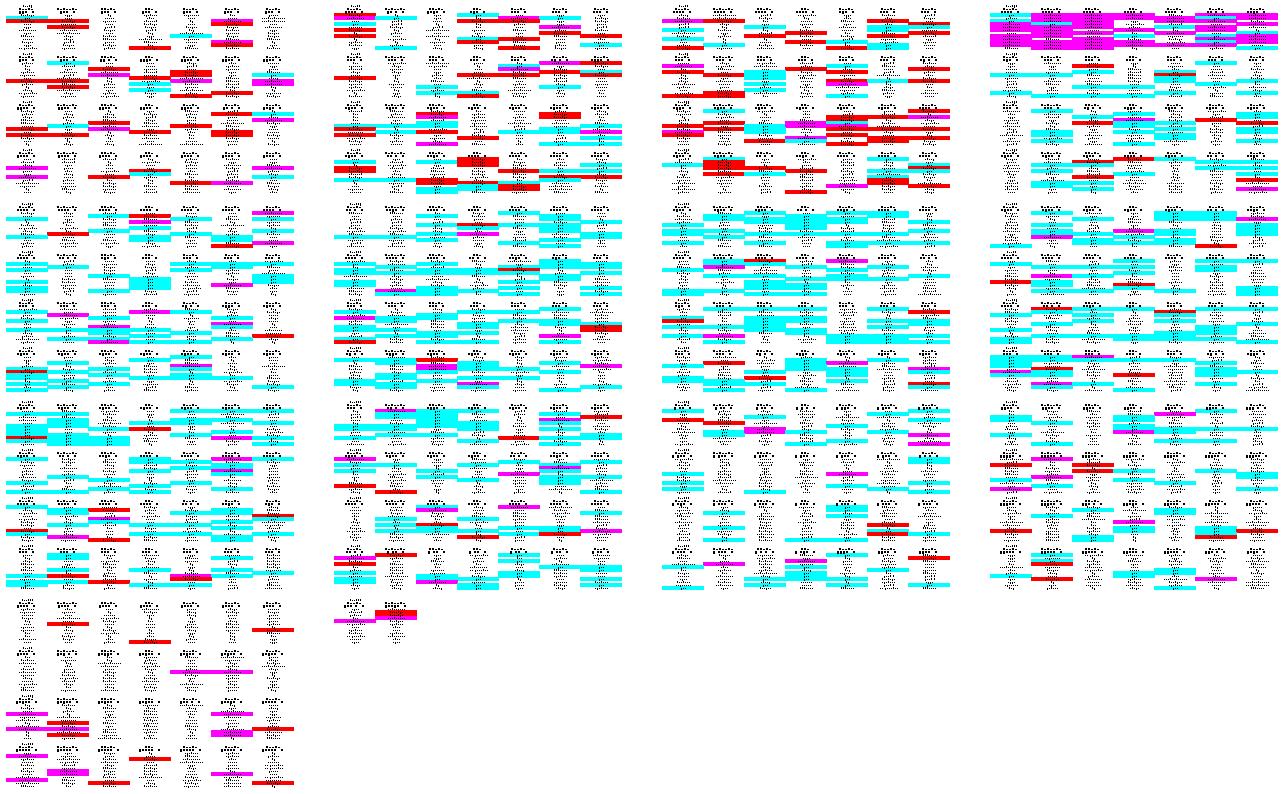
The text has been made very tiny because it is only desirable to show a "big picture" view here. You can view things closer in the simulation.
The hypothetical scenario: The majority of the year, you do all strength training exercises with roughly equal frequency as a general fitness program. These are the tiny black text throughout the graphic. For approximately the first three months of the year you are concentrating on the BENCH PRESS exercise more often due to a weakness that your personal trainer noticed. You also have a fencing competition in the middle of the year, so you are slowly increasing the frequency of the SQUAT exercise until then. After the fencing competition you will decrease the frequency of the SQUAT exercise. About a month or two away from the end of the year you unfortunately have a non-strength-training-related injury, and cannot do the SQUAT exercise for the remainder of the year. Also, one week out of the early part of the year, you concentrate heavily on NECK EXTENSION exercises, due to advice from your doctor.
Please see the simulation. Refreshing the random numbers generates new exercises for each day, yet the planned requirements are satisfied. The programming was done by week, but it can be planned out to the day, like the randomizer shown below.
Balanced Body
Having a balanced body is wise from a medical viewpoint, as well as aesthetics. Exercise is a long-run activity, and given this time and a representative exercise list to sample from, Weighted Exercise may be the only exercise method statistically guaranteed to create a balanced body while simultaneously addressing the aforementioned issues. This can be shown by comparing observed exercise frequencies for a period of time to the expected exercise frequencies using a chi-square goodness of fit test and not seeing a statistically significant p-value.
For example, say we have a representative exercise list, and we let wi = 1 for all exercises. Simulating 5 years of workout days, we get
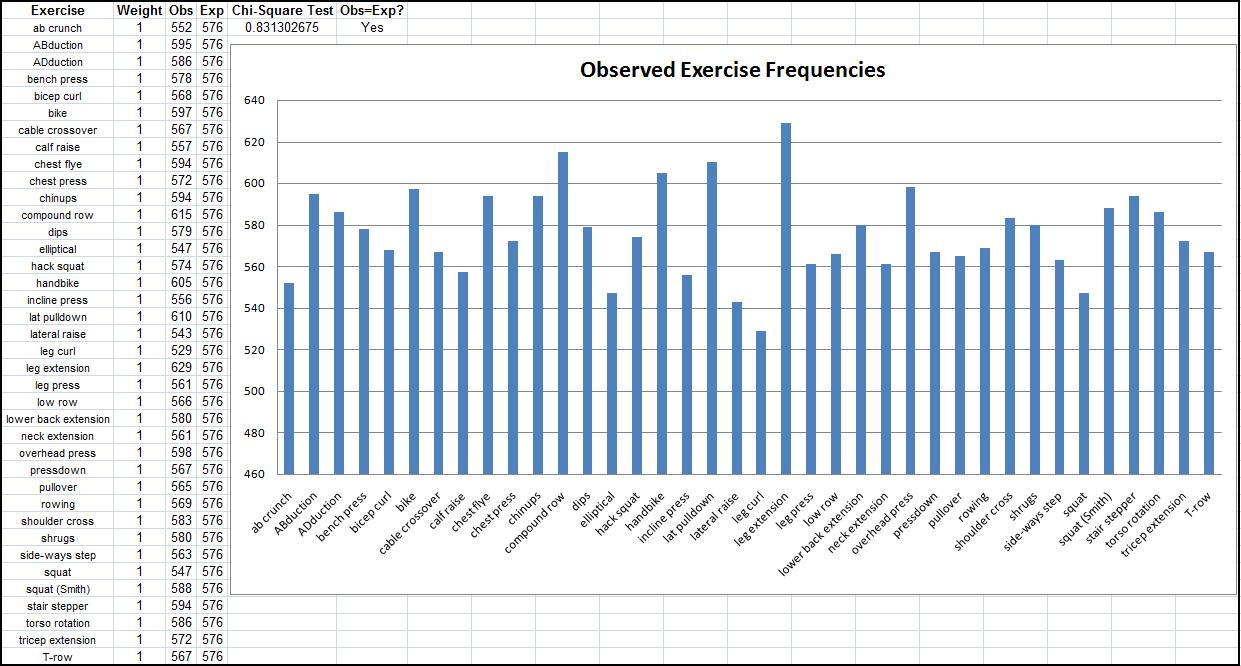
which demonstrates that the observed exercise frequencies are not statistically different from their expected frequencies. If we adjust weights for one or more exercises, this still holds. For example, let wi = 2 for Squat, so Squat is sampled approximately twice as frequently as the other exercises.
Randomizers
I've made two randomizers freely available. Randomizer1 is for creating lists of randomly selected exercises. Randomizer2 is for displaying the exercises on a computer screen, one right after the other.
Randomizer1
Randomizer1 is available here. I am not saying to use this randomizer "as is". You must edit the types of exercises to choose from, the number of exercises to do per workout, and the weights as needed for your goals. The rep and weight lifted parameters and lifting method are also up to you and/or your personal trainer. Upon opening the spreadsheet, it creates a workout for a day. An example is:
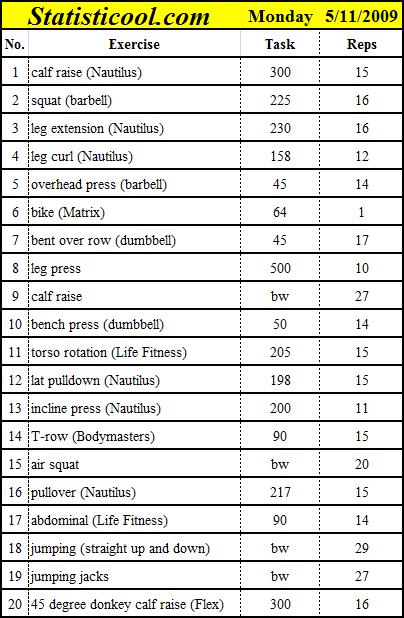
When I go exercise, I'll cut out the list of exercises and slip it into my pocket to refer to during my workout. One could edit this spreadsheet to plan their workouts for an entire week, month, or year.
Randomizer2
Randomizer2 is available here. This is great for displaying exercises in large text that can be seen across the room for use in drills.
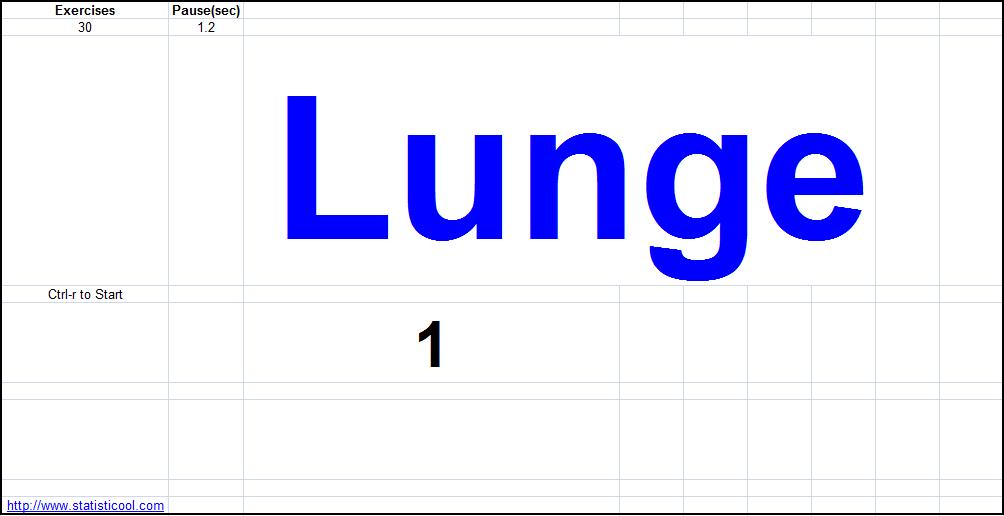
Feel free to edit the fonts, types of exercises to choose from, the number of exercises to do per workout, the exercise weights, and the time between displaying exercises as needed. Upon opening the spreadsheet, enter the parameters in the Parameters tab. Then go into the Selections tab. Make sure you have macros enabled, and then press Ctrl-r to run the macro.
Other Examples of Randomness in Exercise
It was mentioned that introducing randomness into other activities, where appropriate, is endorsed. For example, if a regular ball was dropped straight onto a racket or the ground, it would only bounce in a single predictable path. The reaction ball, however, is only expected to bounce in that same path, and mostly does as the density of the dots from the model indicates, but with smaller probability can bounce to other areas.
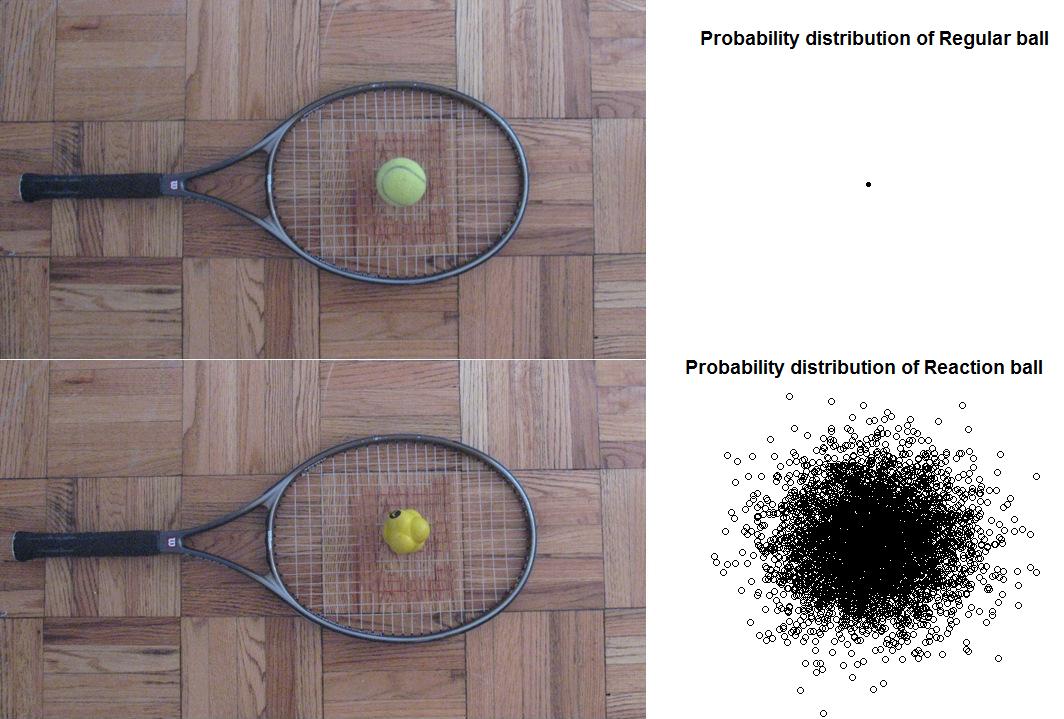
Random exercise could therefore be said to contain deterministic exercise, or put in other words, deterministic exercise is a subset of random exercise, or deterministic exercise is only one realization of random exercise.
Questions and Answers
- "Did you invent the idea of randomly generated workouts?"
There is no question that people have used dice, playing cards, computer programs, etc., to create random workouts. It seems to be an idea that pops up here and there in the history of exercise. However, the tools used were either very limited and/or the reasons for using randomness were very basic, mostly done only to introduce novelty and prevent boredom. Additionally, many people have merely randomly selected deterministically created workouts. Also, people have used random elevation profiles on "cardio" machines. Weighted Exercise is a general methodology for creating and improving such workouts.
- "Is the exercise selection really random?"
Short answer: No.
Long answer: The selection process relies on Excel's current random uniform function. This, like all computerized random number generators, is actually a pseudo-random number generator (PRNG) because it ultimately relies on an algorithm, typically seeded with a number that changes, like the current date or time. Excel's PRNG passes the DIEHARD battery of tests of randomness, which is a standard in the field, as well as additional tests developed by the National Institute of Standards and Technology. For all practical intents and purposes, the exercise selection is random.
- "How can you measure progress if there is randomness?"
Progress would be measured the same way as in deterministic workouts, by examining various biological measurements, performance, as well as the weight lifted and reps done over time and see if the trend line has a statistically significant slope in the appropriate direction. The measurement in Weighted Exercise may even be more meaningful because it isn't conditional on a specific exercise order.
- "Can an exercise fail to be selected for a long period of time?"
It is possible, just not probable. If the exercises are being selected with equal probability, the probability of not selecting an exercise after d workouts, given n and N, is: (1-1/N)nd. Notice that as n and d get larger, this probability gets smaller.
To give a concrete example, say all of my exercises are of two types, Upper and Lower body, and I have 6 exercises for the Upper, and 6 for the Lower in my list to select from. If I do 5 exercises per workout selected out of these 12, and do 3 workouts per week, then the probability of going without any Lower body exercises for 3 weeks is:
P(all Upper body in 9 workouts) = P(all Upper body in 45 selections) = .545
So the probability of getting no Lower body exercises in 3 weeks is an extremely small probability. It is the same probability as flipping a fair coin 45 times and getting Heads 45 times. See the simulation here.
- "What are the total number of possible workouts?"
If you are selecting n exercises with replacement from N exercises, then there are Nn total possible workouts. Consider a specific case, N = 38 and n = 12, so there are 3812 = 9,065,737,908,494,995,456 possible workouts. To get an idea of this staggering number, it is many, many times larger than the number of cells in your body.
Compare this number to the capabilities of popular deterministic workout methods that claim "variety". Most such programs eventually recycle their workouts of the day, but suppose the Earth's entire population followed their method and each one of them created one different workout each day of their lives for 100 years, Weighted Exercise, with these specific parameters, could still create roughly 35,000 times as many workouts. See the simulation here.
- "What about sampling without replacement?"
When one samples without replacement, it effectively makes things less random since more information is being shown. For example, if you draw 51 cards from a deck, you know the 52nd card with certainty. Sampling without replacement is more random than deterministic workouts, but not as random as sampling with replacement. Here is a spreadsheet that gives instructions for sampling without replacement.
- "What about Dynamic Exercise Order?"
Dynamic Exercise Order, as discussed by Drew Baye, is a great idea! It says that whatever exercise you performed the worst on in your current workout, you do that exercise first in your next workout. This is a very sensible way to incorporate variety, address what I call exercise order bias, and emphasize working on weaknesses. The spirit of the method is very much in line with the spirit of some randomization methods. Here is a spreadsheet that demonstrates Dynamic Exercise Order.
- "How is generating random workouts by randomly selecting individual exercises advantageous over randomly selecting deterministic workouts?"
If one randomly selects deterministic workouts, you've only randomized the selections but not the workouts themselves. Therefore, within a workout you'd know what is coming next.
More importantly, the weights assigned for random exercise selection allow us to control the probability of exercise selection. If you're randomly selecting deterministic workouts you may run into issues. For example, if you get injured or don't have a piece of equipment that you once had, you could still be randomly selecting deterministic workouts that include exercises that you cannot do in your present state.
- "What would an environment be like if everyone was doing randomized exercise?"
A gym would probably run a lot smoother if people were doing randomized workouts than if people were doing deterministic workouts. This is because the workouts would not be dependent on a specific exercise order. A person doing such a workout would have no practical or philosophical issue with moving to a different exercise in their workout if an exercise that comes up next on their list is currently in use. Therefore, there aren't any real conflicts.
However, let's examine potential conflicts. Because a randomized workout is mathematical in nature, we can simulate what would happen if everyone in the gym was working out this way. By creating random matrices of dimension nxP, where the rows are the nth exercise in the workout, the columns are people (P), and the entries of the matrices are the exercise label (1 to N), one can show that as n increases, conflicts increase, that as P increases, conflicts increase, and that as N increases, conflicts decrease.
These findings suggest that to reduce potential conflicts, do less exercises per workout (decrease n) and therefore increase the intensity, exercise during non-peak hours so not as many people (decrease P), and have many exercises to choose from (increase N).
- "How can randomness possibly help with exercise and learning?"
There have been numerous other examples of randomness helping people exercise and learn. A few examples are:
- modern science relying on randomization to make inferences of cause and effect and from samples to populations
- using random elevation profiles and intervals on various "cardio" machines
- bouncing irregularly shaped reaction balls
- revitalizing chess with Fisherrandom or chess960 (really Bronstein) chess
- reviewing a well-shuffled deck of flashcards in preparation for an exam
- effectiveness of random drug tests in sport at helping to weed out the cheaters
- improving videogame play by incorporating controlled randomness into the design
- generating strong passwords
- TSA randomly using a playbook to thwart the bad guys
- striking and defending randomly selected target areas for martial arts drills
- learning a foreign language by playing language lessons on your Ipod using the "Shuffle" feature
- Using Wikipedia's random article to learn new things
- me using random sampling as a guide to come up with potato chip flavors for Lay's "Do Us a Flavor" contest
- mixed and behavioral strategies from game theory
- the Dada art movement, Fluxus, etc., computer generated or assisted art
- learning Morse code
- verifying blockchain transactions
- randomized auditing by tax authorities
- randomization being essential for differential privacy
- random distribution of fibers making masks more effective in stopping particles
- Ed Parker's prefix, suffix, insertion, deletion, combinations idea in American Kenpo.
- Hiphop artist Germaine Williams's (Canibus) "infinite rhyme" method of creating hiphop music
- Charles Staley's "Structural Versus Randomized Training Concepts"
- Dan John
- CrossFit with their Hopper model and Hopper deck
- The Electronic Multi-User Randomized Circuit Training (EMURCT) system ..."has been developed using pervasive computing concepts to address the issues of monotony and lose of motivation in routine circuit training workouts."
- RossTraining with their deck
- http://www.manvfitness.com/452/randomization-for-lean-muscle-gain-strength-movement-do-it/
- Plandomization by Greg Everett
- Don Stevenson with Octogen Fitness
- CHAOS training with Coach Dos
- LaFosite, doing randomized workouts
- WodShop
- The makers of reaction balls and the sports teams that use them
- The Secrets of Sticking With It by Chris Cooper, reports that "The variable that produced the biggest result was novelty. We'd always taken great pride in never giving a client the same workout prescription twice. When we applied this tenet to our study, we found that not knowing what would come next improved adherence nearly 15 percent alone."
- The makers of all "cardio" equipment that incorporate a "Random" elevation or interval profile
- Andrew Heffernan
- Adding randomness to Primal Blueprint Fitness
- Drew Baye's "dynamic exercise order", via Joe Mullen
- Arthur Devany's views on variety and symmetry
- And many, many more...
Please anonymously VOTE on the content you have just read:
Like:Dislike: